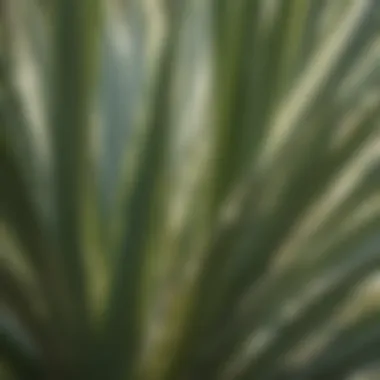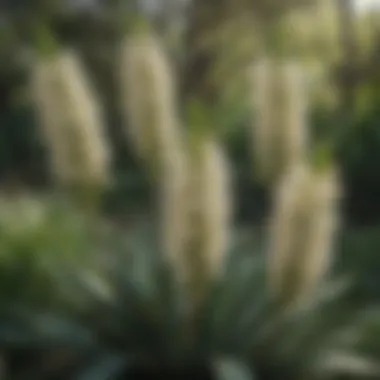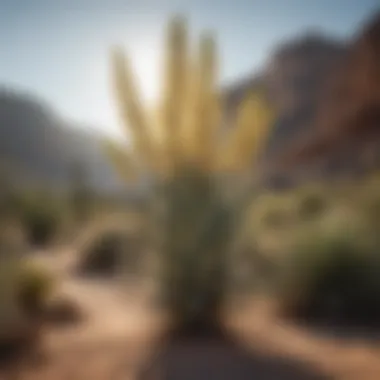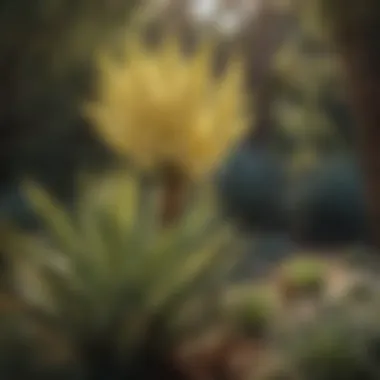Exploring the Unique Visual Traits of Yucca Plants


Intro
The yucca plant is a distinctive member of the agave family. Its unique visual features make it easily recognizable in various landscapes. Understanding these characteristics is essential for appreciating its role in the ecosystem. Morphological traits such as the leaf structure, flower arrangement, and overall shape define the yucca's appearance. These aspects not only serve aesthetic purposes but also influence the plant's adaptability and function in its environment.
Yucca plants thrive in arid and semi-arid regions, contributing to the biodiversity of their habitats. Learning about the yucca's visual traits can inform horticultural practices and conservation efforts. The article aims to present a detailed examination of the yucca's physical attributes while contextualizing its ecological significance.
Leaf Structure
One of the most striking visual characteristics of the yucca plant is its leaf structure. Yucca leaves are typically long, narrow, and pointed, resembling swords. This shape is an adaptation to conserve water in dry conditions. Leaves can vary in color, ranging from vibrant green to bluish-green, depending on the species. The edges of the leaves often have sharp teeth which may discourage herbivory.
The basal rosette formation of leaves gives the yucca plant a distinct look. This rosette comprises multiple leaves emerging from the base, often creating a compact and aesthetically pleasing shape. The leaf arrangement can influence light capture, optimizing photosynthesis in harsh environments.
Flower Arrangement
Yucca flowers are another notable feature that sets it apart from other plants. The flowers typically emerge from tall stalks that rise above the leaves. Each stalk can carry numerous white or cream-colored blossoms that bloom in clusters. The flowers often have a waxy texture, making them attractive to pollinators, particularly moths.
The flowering season varies by species and climate. The ability to produce beautiful flowers adds significant value to the yucca's appeal. It serves as a key identifier for many horticulturists and plant enthusiasts.
Overall Plant Shape
The overall shape of the yucca plant is a blend of a rosette base and tall flowering spikes. This combination creates a bold silhouette in any landscape. Yucas can reach different heights depending on the species. Some species are short and compact, while others grow significantly taller.
The plant's firmness and structure also play an essential role in its ecological interactions. The robust form provides stability in windy conditions, allowing the yucca to thrive in otherwise challenging environments.
Ecological Significance
The ecological impact of the yucca plant extends beyond its visual appeal. It serves as a crucial resource for various wildlife species. The flowers provide nectar for pollinators, while the leaves can offer shelter for insects. Furthermore, yucca plants tend to improve soil health through their extensive root systems, promoting nutrient cycling.
"Yucca plants are integral to their ecosystems. Their morphological characteristics enable them to interact dynamically with their environment, providing numerous ecological benefits."
The End
Prelude to the Yucca Plant
The yucca plant holds a unique position in the realm of botany and horticulture. Its striking visual characteristics render it a popular choice for landscaping and decorative applications. Understanding the yucca’s attributes not only enriches appreciation for its aesthetic quality but also unveils the ecological and functional significance it carries within its native environments.
Yucca plants are well-known for their distinctive leaf structure, which can vary significantly across different species. The leaves are typically long and sword-like, boasting sharp edges. These features serve multiple purposes; they not only provide visual intrigue but also help the plant withstand arid conditions. In many arid and semi-arid habitats, yuccas have adapted remarkably to conserve water.
Moreover, the flowers of yucca plants present a captivating sight during their blooming periods. The flower spikes can be imposing and often showcase clusters of trumpet-shaped blooms. This aspect of yucca plants is critical in various ecological dynamics, particularly with pollinators such as moths and certain species of bees.
In the broader scope of this article, we will delve deeper into the specific visual traits of the yucca, including:
- The overall appearance of the yucca plant.
- Variations in leaf structure, covering shape, size, color, and texture.
- The characteristics of flower arrangements and their blooming cycles.
- Vital aspects of growth habit, including height, width, growth rate, and life span.
Such knowledge not only enhances visual appreciation but also informs proper cultivation strategies. Yucca plants can thrive in diverse environments, thus making them an interesting subject for forestry professionals and academics alike. Given their resilience and adaptability, yuccas can be significant contributors to landscape ecology, serving as habitat and food sources within their ecosystems. Understanding these elements is crucial for anyone working or studying in botanical and ecological fields.
Taxonomy of Yucca
Understanding the taxonomy of the yucca plant is crucial for many reasons. Firstly, it provides a framework for categorizing the extensive diversity within the species. This classification facilitates scientific communication and aids in conservation efforts. Academics and forestry professionals benefit from a clear taxonomy as it enhances their ability to study the plants, assess their ecological roles, and optimize their cultivation practices. The importance of taxonomy lies not just in naming but also in grouping plants based on their characteristics and evolutionary relationships.
Classification


Yucca plants belong to the family Asparagaceae, which supports a variety of flowering plants. These plants are primarily characterized by their rosettes of stiff, sword-like leaves and unique flowering structures. Within the genus Yucca, different species exhibit diverse adaptations and visual traits. This classification scheme helps in distinguishing species based on morphological and genetic data.
Key characteristics used in classification include:
- Leaf structure
- Flower type and arrangement
- Growth habit Such classification is essential for conservationists who work to protect specific yucca species and their habitats.
Family and Genus
The family Asparagaceae includes various generas, but the genus Yucca is particularly intriguing due to its unique adaptations to arid environments. This genus is native to North and Central America. It exemplifies how plants evolve to thrive in specific habitats. Yucca plants are well-known for their resilience against harsh conditions.
The genus Yucca is significant for its diverse range of species, each with particular physical features that appeal to both forestry professionals and ornamental gardeners. Recognizing the differences among the yucca species is pivotal for understanding their ecological roles and potential uses in landscaping or horticulture.
Physical Characteristics
Physical characteristics are essential in understanding the yucca plant. The way the plant looks—their shapes, sizes, leaf structures, and flowers—play a key role in identifying different species. This section emphasizes how visual traits contribute to ecological functionality and adaptability. Recognizing these traits can help in conservation efforts and horticulture practices. It is not only about beauty but how those visuals impact the plant's survival and interaction with its environment.
Overall Appearance
The overall appearance of the yucca plant is marked by its robust form. These plants typically display a central rosette of leaves with towering flower stalks that rise above the foliage. The height and spiky leaves create a striking silhouette against diverse backgrounds. Commonly, yuccas have a rugged, architectural quality, which not only enhances aesthetic appeal but also serves practical purposes, such as water conservation.
Leaf Structure
Shape and Size
Yuccas exhibit a range of leaf shapes. Many have long, narrow, sword-like leaves. This shape is crucial as it reduces water loss by minimizing surface area exposed to the sun. The size varies widely among species, with some having leaves measuring up to three feet in length. Such length can be advantageous in capturing more sunlight.
Color Variations
Color variations in yucca leaves are notable. They can range from deep green to blue-green shades. Some varieties may present a yellow or white edge. These colorations offer a visual contrast that can enhance landscape design. However, certain colors might indicate specific environmental adaptations or stress levels, informing care practices for gardeners.
Texture and Edge
The texture of yucca leaves is mostly smooth but can exhibit serrated edges. Smooth surfaces help in shedding water during rains, while serrated edges can deter herbivores. Such features serve both ecological and aesthetic functions, enriching the plant's ability to thrive in harsh conditions.
Flowering Characteristics
Flower Types
Yuccas produce distinct flowers, generally characterized by their creamy white or pale yellow colors. These tubular flowers are grouped in large clusters, adding significant ornamental value. Their structure is well-designed to attract specific pollinators, such as yucca moths, fostering symbiotic relationships.
Blooming Period
The blooming period of yuccas mainly occurs during late spring or early summer. This timing aligns with warmer weather, maximizing pollination opportunities. Timing is crucial; specific bloom schedules can impact local ecosystems and invite seasonal visitors, including various insects.
Pollination
Pollination in yuccas is largely facilitated by yucca moths. This unique relationship ensures genetic diversity and sustains the plant population. The dependency on specific pollinators underlines the ecological significance of yuccas and their vulnerabilities to habitat changes.
Growth Habit
Height and Width


Yuccas can significantly vary in height, typically somewhere between one and ten feet tall. Some large species may spread wide, making them excellent options for landscaping. A yucca’s height can influence its environmental role and suitability for different settings.
Growth Rate
The growth rate of yuccas is generally slow, advancing a few inches each year. This pace requires patience from growers, but once established, they can thrive for many years. Their slow growth could be seen as a disadvantage in immediate gardening impact but offers resilience over time.
Life Span
Yuccas are known for their longevity, with some varieties living for decades, if not longer. This life span encourages long-term planning in garden design and landscaping. Such durability contributes to their appeal among forestry professionals, who recognize their value in sustainable design.
Common Varieties of Yucca
The section on common varieties of yucca is significant because it delineates the specific types that are prevalent in various ecological zones. Understanding these varieties aids in recognizing their unique features, adaptability to environments, and applications in landscaping and biodiversity.
Yucca filamentosa
Habitat
Yucca filamentosa thrives in diverse habitats, favoring sandy or well-drained soils, typical of coastal environments and dry plains. It is commonly found in the southeastern United States. This preferred habitat allows the plant to establish deep root systems which can withstand drought. Its ability to adapt to poor soil conditions is beneficial for areas that may not support other vegetation. However, it requires plenty of sunlight, so shaded areas are not suitable, limiting its potential planting locations.
Yucca glauca
Habitat
Habitat for Yucca glauca includes dry grasslands and rocky slopes, primarily across the central United States. Its preference for these environments highlights its resilience to drought and poor soil quality. This adaptability allows it to thrive in areas where other plants may struggle. Its unique feature of flourishing in such harsh conditions makes it a popular choice for both residential and commercial landscaping. However, its need for full sun does restrict its cultivation in shaded areas.
Yucca brevifolia
Habitat
The native habitat of Yucca brevifolia is the Mojave Desert, where it flourishes in rocky, well-drained soils. This habitat supports a variety of other desert plants and wildlife, making Yucca brevifolia an essential part of the desert ecosystem. Its unique feature of thriving in such a biome emphasizes its importance in conserving desert habitats. However, its strict environmental needs can pose a disadvantage for cultivation outside its native range, where consistency in climate may not be achievable.
Habitat and Distribution
Understanding the habitat and distribution of the yucca plant is critical for several reasons. Firstly, it provides insights into the ecological requirements that allow this species to thrive. By examining where yucca plants are found, we can also look at their adaptation to various environments. Additionally, this knowledge helps in conservation efforts, ensuring their habitats are protected which is vital for maintaining biodiversity. Knowing these details can help forestry professionals and academics make informed decisions on cultivation and preservation practices.
Native Regions
Yucca plants are predominantly found in the Americas, with a significant presence in areas like the southern United States, Mexico, and parts of Central America. In the United States, species such as Yucca filamentosa and Yucca glauca are native to arid regions. The climates vary widely, from deserts to subtropical zones. Specific species have adapted to these diverse environments, showcasing their resilience.
The native regions also influence the plant's physical characteristics. For instance, those in dryer areas may display thicker leaves and shorter growth habits. This adaptation allows them to conserve water, emphasizing their ability to thrive in challenging conditions.
Preferred Environments
Yucca plants favor environments characterized by well-drained soils and abundant sunlight. They are commonly found in:
- Deserts: Where moisture levels are low and sunlight is plentiful.
- Grasslands: Often, yucca plants coexist with grasses and other perennial plants.
- Scrublands: Here, they thrive in poorer soil conditions.
These environments play a key role in the yucca’s lifecycle, dictating water needs and soil requirements. The adaptability of these plants to different soil types, such as sandy or rocky terrains, is noteworthy. Their extensive root systems allow them to penetrate deeply into the earth, accessing moisture far below the surface.
"Yucca plants are ecological specialists; they manage to survive and thrive in some of the harshest conditions."


In summary, the habitat and distribution of the yucca plant reveal essential information about its survival strategies and ecological relationships. A comprehensive understanding of these factors can inform conservation efforts and cultivation practices, ensuring that these distinct species are preserved for future generations.
Ecological Significance
The yucca plant occupies a significant position within various ecosystems. Understanding its ecological significance contributes greatly to the broader study of plant interactions and community dynamics. The yucca not only provides essential components to its habitat but also plays a role in sustaining various forms of life.
Role in Ecosystems
Yucca plants serve as key players in their native environments. They have the capacity to support a variety of wildlife. One of the most critical aspects is their role in providing food sources. The flowers and fruit of yucca are nutritious for many animals. For example, the blooms are often pollen-rich, attracting pollinators such as bees and moths. This interaction facilitates the reproductive strategies of both the yucca and its pollinators, leading to healthy population dynamics for both.
Moreover, the structure of yucca plants provides shelter for small animals. The leaves, which are sharp and pointed, can help deter herbivores, thus protecting the plant and offering a refuge for various creatures. In grassy or scrub environments, yucca plants create a microhabitat that supports a diversity of species, thereby enriching the ecosystem.
“The yucca's interdependence with its environment highlights the intricate balance of ecological relationships.”
Symbiotic Relationships
Yucca plants are famous for their symbiotic relationships, particularly with specific species of moths. The yucca moth, for instance, has evolved alongside yucca plants, forming a mutualistic bond. The moth lays its eggs within the flowers while pollinating them. This relationship ensures yucca seeds develop while also providing a food source for the young moths when they hatch.
The unique structure of yucca flowers supports this process. The blooms usually open at night, aligning with the nocturnal behaviors of the yucca moth. This timing maximizes the efficiency of pollen transfer and enhances reproductive success for both organisms. As such, this relationship exemplifies how plants and animals adapt to one another in their evolutionary processes.
In addition to yucca moths, other insects and creatures also interact with yucca plants. Their adaptations and the benefits they derive from yucca show the complex tapestry of life that exists thanks to these hardy plants. By understanding these symbiotic relationships, researchers can gain insights into ecosystem health and resilience.
Care and Cultivation
Understanding the care and cultivation requirements of the yucca plant is crucial for both enthusiasts and professionals. Proper care maximizes the plant's health and vibrancy, ensuring that its striking visual characteristics are on full display. The cultivation of yucca demands a keen awareness of certain factors, including growing conditions, watering needs, and soil requirements, all of which contribute to the sustained well-being of this resilient plant.
Growing Conditions
Yucca plants thrive in environments that closely mimic their native habitats. They prefer full sun exposure, leading to robust growth and vibrant foliage. In terms of temperature, yucca can tolerate a wide range, but ideally, it flourishes in warm conditions, preferably above 60°F (15°C). These plants exhibit drought resistance, making them suitable for arid landscapes. A well-drained environment is vital since yucca is susceptible to root rot when overwatered.
Additionally, spacing between plants is an essential consideration. Adequate spacing allows for proper air circulation, which helps prevent fungal diseases. When planting multiple yuccas, consider positioning them at least 2 to 3 feet apart for optimal growth.
Watering Needs
The watering needs of the yucca plant are relatively modest, reflecting its adaptability to drought-like conditions. For newly planted yuccas, it is advisable to water them regularly for the first few months to establish a strong root system. However, once established, yuccas require less frequent watering. It is essential to let the soil dry out between watering sessions. An indicator to assess this is to check the top inch of the soil; if it feels dry, it is time to water. Overwatering can lead to a myriad of problems, including root rot, which is detrimental to the plant's health.
In regions with high humidity, careful observation is necessary. Reduced watering frequencies may be required as the plant can receive excess moisture from the air. Observing the leaves for signs of overwatering or underwatering can provide valuable insights into the plant's hydration needs.
Soil Requirements
The soil requirements for yucca plants revolve around drainage. They thrive in sandy or rocky soils that facilitate water drainage. A well-aerated potting mix, often containing components like perlite or gravel, can support optimal growth if you are cultivating them in pots. The pH level of the soil should ideally be between 6.0 and 8.0, allowing for the proper nutrient uptake.
Adding organic matter can be beneficial, as it improves soil structure and moisture retention without leading to waterlogged conditions. Regularly testing the soil can help identify nutrient deficiencies, allowing for timely amendments.
"Appropriate soil choice and maintenance are as vital as light and water in the successful cultivation of yucca plants."
In summary, the care and cultivation of yucca plants hinge on understanding their specific needs. Addressing growing conditions, watering routines, and soil types will not only ensure the plant's health but will also enhance its unique visual traits, making it a standout feature in any landscape.
End
The leaf structure, characterized by its blade shape, offers insights into the plant's resilience against harsh conditions. Furthermore, the flowering characteristics denote its reproductive strategies, which are vital for species propagation.
Key Takeaways:
- Yucca plants exhibit diverse leaf forms and colors, enhancing their aesthetic value.
- Their flowers play a role in attracting pollinators, demonstrating their ecological importance.
- Knowledge of their growth habits helps in effective cultivation and care practices.
This awareness is beneficial not only for forestry professionals seeking to integrate yuccas into their projects but also for academics studying plant adaptations. Moreover, by recognizing the importance of yucca in its ecosystem, we can advocate for conservation efforts that sustain its populations in the wild.
"The yucca plant is a testament to nature's ingenuity in surviving and thriving in varied environments."



